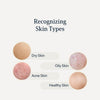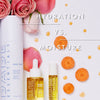Hydration vs. Moisture in Skincare: Understanding the Difference and How to Treat Each with Babe Essentials

In the realm of skincare, terms like "dehydration" and "moisture" often get thrown around interchangeably. However, these terms refer to distinctly different issues, each requiring unique approaches and solutions. Understanding the difference between dehydrated skin and moisture-deficient skin is crucial for achieving a healthy, radiant complexion. In this article, we’ll explore what dehydration and moisture mean in the context of skincare, identify the key differences between them, and provide effective strategies and ingredients to address each condition. Plus, we’ll highlight some of Babe Essentials' top products that can help protect and enhance your skin barrier.
Understanding Dehydrated Skin: What is Dehydrated Skin?
Dehydrated skin lacks water. It’s a condition that can affect any skin type, including oily and combination skin. Dehydration is characterized by a deficiency of water within the skin’s layers, leading to a dull complexion, fine lines, and a tight, uncomfortable feeling.

Causes of Dehydrated Skin
Dehydrated skin can result from various factors, including:
Environmental Influences: Exposure to harsh weather conditions, such as extreme cold or heat, and air conditioning or heating can strip moisture from the skin.
Lifestyle Choices: Poor hydration, excessive alcohol consumption, and a diet lacking in fruits and vegetables can lead to dehydration.
Improper Skincare Routine: Over-exfoliating, using harsh cleansers, and neglecting to use hydrating products can impair the skin’s ability to retain water.
Aging: As we age, the skin’s ability to retain moisture decreases, making it more susceptible to dehydration.
Signs of Dehydrated Skin
Dull, Lackluster Appearance: Skin may look tired and lack its usual glow.
Fine Lines and Wrinkles: Dehydration can make fine lines more prominent.
Tightness and Sensitivity: The skin may feel tight, especially after cleansing, and can be more sensitive than usual.
Flakiness: Dehydrated skin can sometimes flake, although this is more commonly associated with dry skin.
How to Treat Dehydrated Skin
To effectively treat dehydrated skin, focus on restoring the skin’s water content. Here are some key strategies and ingredients:
Hydrating Ingredients
Hyaluronic Acid: Known for its exceptional water-retaining properties, hyaluronic acid can hold up to 1000 times its weight in water, making it a powerhouse for hydration.
Glycerin: A humectant that attracts water from the environment into the skin, helping to keep it hydrated.
Aloe Vera: Offers soothing and hydrating benefits, making it ideal for replenishing moisture in dehydrated skin. Find it in Babe Essentials The Cure Serum.
Panthenol (Provitamin B5): Helps to improve hydration, reduce itching and inflammation, and accelerate healing.
Babe Essentials Hydrating Products
Aloe Water Essence/Toner: This lightweight toner is packed with hydrating aloe vera, making it perfect for replenishing lost moisture and soothing the skin.
Rose Water Toner: Known for its hydrating and calming properties, our rose water toner is excellent for adding a boost of hydration and revitalizing the skin.
Cure Aloe Vera Clarifying Serum: This serum not only hydrates but also clarifies the skin, making it ideal for those looking to address dehydration and achieve a clear, radiant complexion.
Understanding Moisture-Deficient (Dry) Skin: What is Moisture-Deficient Skin?
Moisture-deficient, or dry skin, lacks oil (sebum). Unlike dehydrated skin, which lacks water, dry skin is a skin type characterized by an insufficient production of natural oils. This deficiency can lead to a compromised skin barrier, making the skin more prone to irritation and environmental damage.
Causes of Dry Skin
Dry skin can be caused by a variety of factors, including:
Genetics: Some people are naturally predisposed to having dry skin.
Aging: As the skin ages, it produces less sebum, leading to dryness.
Climate: Cold, dry air can strip the skin of its natural oils.
Skincare Products: Overuse of products with harsh ingredients or those that strip the skin of its natural oils can exacerbate dryness.
Medical Conditions: Conditions like eczema and psoriasis can lead to extremely dry skin.
Signs of Dry Skin

Rough Texture: Skin may feel rough and look flaky.
Itching: Dry skin often feels itchy and uncomfortable.
Redness and Irritation: The skin can become red and irritated due to its compromised barrier.
Cracks and Fissures: In severe cases, dry skin can crack and even bleed.
How to Treat Dry Skin
To effectively treat dry skin, the focus should be on restoring and maintaining the skin’s oil content. Here are some key strategies and ingredients:
Moisturizing Ingredients
Ceramides: Essential for restoring the skin barrier and locking in moisture.
Shea Butter: A rich emollient that helps to nourish and protect the skin.
Squalane: Mimics the skin’s natural oils, providing lightweight yet effective hydration.
Oils (Jojoba, Argan, Rosehip): These oils help to replenish the skin’s natural lipid barrier and provide deep nourishment.
Fatty Acids: Omega-3 and omega-6 fatty acids help to repair and maintain the skin barrier.
Babe Essentials Moisturizing Products
Multitasker Face Oil: Packed with a blend of natural oils, this face oil provides deep hydration and nourishment, making it perfect for addressing moisture-deficient skin.
Wrinkle No More Face Oil: This luxurious oil is formulated with anti-aging ingredients and natural oils to hydrate deeply and smooth out fine lines.
Rescue Face Oil: Designed to rescue dry, irritated skin, this face oil is rich in essential fatty acids and antioxidants to restore and protect the skin barrier.
Combining Hydration and Moisture
In many cases, skin can be both dehydrated and dry, meaning it lacks both water and oil. Addressing both concerns involves a combination of hydrating and moisturizing products.
A Balanced Skincare Routine
Hydrating Serum: Start with a hydrating serum like Babe Essentials' Cure Aloe Vera Clarifying Serum to replenish water content.
Moisturizing Cream: Follow with a rich moisturizer to lock in hydration and provide necessary oils.
Layering Products: Layering products strategically can help achieve optimal hydration and moisture. For instance, apply a hydrating toner or essence first, followed by a hydrating serum, and then a moisturizing cream.
Key Ingredients for Both Dehydration and Dryness
Niacinamide: Helps improve the skin barrier, enhances hydration, and regulates oil production.
Ceramides: Both hydrating and moisturizing, ceramides are essential for repairing the skin barrier.
Natural Moisturizing Factors (NMFs): These include amino acids, urea, and lactates that help maintain hydration and support the skin’s lipid barrier.
Conclusion
Understanding the difference between dehydration and moisture deficiency is crucial for tailoring your skincare routine to meet your skin’s specific needs. Dehydrated skin needs water, while dry skin needs oil. By incorporating the right ingredients and following a balanced skincare routine, you can effectively address both concerns, leading to healthier, more radiant skin.
Babe Essentials offers a range of products designed to protect and enhance your skin barrier, whether your skin is dehydrated, dry, or both. From our hydrating Aloe Water Essence/Toner and Rose Water Toner to our deeply nourishing face oils like Multitasker, Wrinkle No More, and Rescue, you can find everything you need to achieve and maintain a healthy complexion.
Remember, the key to effective skincare is consistency and listening to your skin’s needs. Whether your skin is dehydrated, dry, or both, there are solutions available to help you achieve and maintain a healthy complexion. Happy skincare journey!















